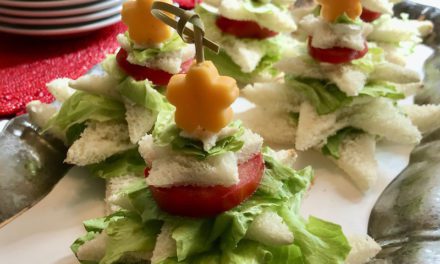 This is the second summer that Vince has planted a complete herb garden in our yard. It’s so wonderful to walk out back and harvest fresh herbs for our meals every evening. This week’s recipes all feature fresh herbs. If you don’t have an herb garden you can usually find them at your local supermarket or better yet – at one of our many farmers’ markets. Enjoy!
This is the second summer that Vince has planted a complete herb garden in our yard. It’s so wonderful to walk out back and harvest fresh herbs for our meals every evening. This week’s recipes all feature fresh herbs. If you don’t have an herb garden you can usually find them at your local supermarket or better yet – at one of our many farmers’ markets. Enjoy!
Basil (Ocimum basilicum): Called the “royal herb” by ancient Greeks, this annual is a member of the mint family. Fresh basil has a pungent flavor that some describe as a cross between licorice and cloves.
It is a key herb in Mediterranean cooking, essential to Italian pesto and is becoming more and more popular in American cuisine. Choose evenly colored leaves with no sign of wilting. Refrigerate basil, wrapped in barely damp paper towels in a plastic bag for up to 4 days. Basil has traditional uses as a digestive aid and an herbal tonic as well as being used in aromatherapy.
Basil, Tomato and Mozzarella Tartines
Thin baguette, sliced into rounds
Melted butter
Olive oil
Fresh Mozzarella cheese
Campari tomatoes
Fresh basil leaves
Balsamic vinaigrette
Place bread slices on a baking sheet. Combine butter and olive oil, to taste, and brush on bread slices. Broil until toasted. Top with slice of tomato, basil leaf and slice of cheese. Before serving, drizzle with balsamic vinaigrette. Garnish with chopped basil. Serve immediately. (To serve warm: heat in 350 degree oven until cheese begins to melt. Drizzle with vinaigrette and garnish with basil before serving.)
Chives (Allium schoenoprasum): Related to the onion and leek, chives have a mild flavor and are available year-round. Look for those with a uniform green color and no signs of wilting or browning. Store in a plastic bag in the refrigerator for up to a week. Fresh chives may be snipped with scissors to the desired length. They should be added toward the end of cooking time to retain their flavor. Chives are a good source of vitamin A and contain a fair amount of potassium and calcium. Chives are also among the ingredients of the traditional fines herbes mixture.
Chive and Swiss Muffins
1 cup self-rising flour
½ cup sour cream
½ cup butter, melted
½ cup shredded Swiss cheese
Fresh chives, minced
Stir together all ingredients just until blended. Spoon batter into a lightly-greased miniature muffin pan, filling to the top. Bake in a preheated 375 degree oven for 14 -17 minutes or until lightly browned. Makes approximately 20 muffins.
Cilantro (Coriandrum sativum): Cilantro (also called Chinese parsley or coriander) has a lively, pungent fragrance that some describe as “soapy.” It is widely used in Asian, Caribbean and Latin American cooking and its distinctive flavor lends itself to highly spiced foods. Choose leaves with a bright, even color and no sign of wilting. Cilantro may be stored for up to 1 week in a plastic bag in the refrigerator. Both the leaves and stems can be used in fresh or cooked dishes.
Cilantro Corn Relish
2 teaspoons ground cumin
1 red onion, chopped
1 cup cider vinegar
½ cup sugar
8 teaspoons fresh oregano or 4 teaspoons dried oregano
1 large jalapeno pepper, seeded and chopped
1 teaspoon salt
3 cans yellow corn, drained
1 red bell pepper, diced
2/3 cup minced fresh cilantro
In a medium saucepan, heat the cumin, onion, vinegar, sugar, oregano, jalapeno and salt. Bring to a boil and simmer for 5 minutes. Add the bell pepper and corn and simmer for 3 to minutes. Spoon into a container, cover and refrigerate. Stir in cilantro just before serving. Use within 1 week. Serve with enchiladas, burritos, burgers and grilled meats.
Mint (Mentha species): Long a symbol of hospitality, Greek mythology claims that mint was once the nymph Mentha. She angered Pluto’s wife Persephone, who turned her into this aromatic herb. There are over 30 species of mint, the two most popular and widely available being peppermint and spearmint. Mint is used in both sweet and savory dishes and in drinks such as the famous mint julep and mint tea.
Lime Mint Tea
8½ cups water, divided
6 tea bags
2 cups loosely packed fresh mint leaves, chopped
1½ cups sugar
1-3/4 cups lemon juice
1/3 cup fresh lime juice
Fresh mint to garnish
Bring 4 cups water to a boil in a large saucepan; pour over tea bags. Cover and steep 5 minutes; discard tea bags. Stir in mint; let stand 15 minutes. Pour tea through a wire-mesh strainer into a bowl, discarding mint. Bring remaining 4¼ cups water and sugar to a boil in saucepan; cool. Stir in tea and juices. Chill; serve over ice. Garnish, if desired. Serves 10 to 12.
Oregano (Origanum species): Greek for “joy of the mountain,” oregano was almost unheard of in the United States until soldiers came back from Italian assignments after World War II. This herb belongs to the mint family and is related to both marjoram and thyme. Because of its pungency, caution is recommended in its use. Oregano goes extremely well with tomato-based dishes and is a familiar pizza herb.
Herb-Olive Oil Dip for Bread
¼ – ½ teaspoon crushed red pepper
½ teaspoon ground black pepper
1 teaspoon oregano
1 teaspoon rosemary, finely chopped
1 teaspoon basil
1 teaspoon parsley
1 teaspoon garlic powder
1 teaspoon minced fresh garlic
½ teaspoon salt
¼ -1/3 cup extra virgin olive oil
Combine first 9 ingredients in a small bowl. Mix until blended. Stir in olive oil. Serve with fresh French or Italian bread cubes.
Parsley (Petroselinum crispum): A basic herb of many cuisines, parsley is one of the main components of bouquet garni. Use the leaves chopped up or whole in salads, as a garnish or as a flavoring for sauces and soups. There are several varieties of parsley including curly-leaved parsley with tightly curled moss-like leaves and Italian or flat-leaved parsley. Italian parsley is delicious in both salads and cooked dishes. The chopped leaves of parsley freeze well and whole leaves can be dried for winter use. In ancient times parsley wreaths were used to ward off drunkenness — though proof of their efficacy in that capacity is scarce. It is said that chewing parsley after drinking alcohol or eating garlic freshens the breath.
Tabbouleh
1 cup bulgur wheat
1 cup boiling water
¼ cup extra virgin olive oil
1/3 cup lemon juice
Salt (up to 1 teaspoon), to taste
¼ teaspoon garlic powder
1 tablespoon freshly chopped oregano or 1 teaspoon dried oregano
Dash of cayenne pepper
8 green onions, chopped
Fresh mint leaves, chopped
2 bunches curly parsley, chopped
1 large tomato, diced
1 (2.25 ounce) can sliced black olives, drained
In a medium bowl, pour boiling water over 1 cup of bulgur wheat. Let sit for 30 minutes. Mix olive oil, lemon juice, salt, garlic powder, oregano and cayenne in a small bowl. Pour over bulgur. Stir in parsley, mint and onion. Fold in diced tomato and black olives. Refrigerate for 8 hours before serving.
Rosemary (Rosmarinus officinalis): Used since 500 B.C., rosemary is native to the Mediterranean area where it grows wild. Early-on this mint-family member was used to cure ailments of the nervous system. Rosemary can be used in a variety of dishes including salads, soups, vegetables, meats (particularly lamb), fish and egg dishes, stuffings, and dressings. Use flowers and chopped young leaves in salads.
Orange-Rosemary Vinaigrette
¼ cup olive oil
2 teaspoons Dijon mustard
¼ cup frozen orange juice concentrate, thawed
2 tablespoons red wine vinegar
2 cloves garlic, minced
¼ teaspoon salt
½ teaspoon paprika
1/8 teaspoon cayenne pepper
1/8 teaspoon black pepper
1 tablespoon minced fresh rosemary leaves
Combine all ingredients. Cover and refrigerate. Makes about 1 cup.
The writer owns Catering by Debbi Covington and is the author of the cookbook, Dining Under the Carolina Moon. Debbi’s website address is www.cateringbydebbicovington.com. She may be reached at 525-0350 or by email at debbic@cateringbydebbicovington.com.








